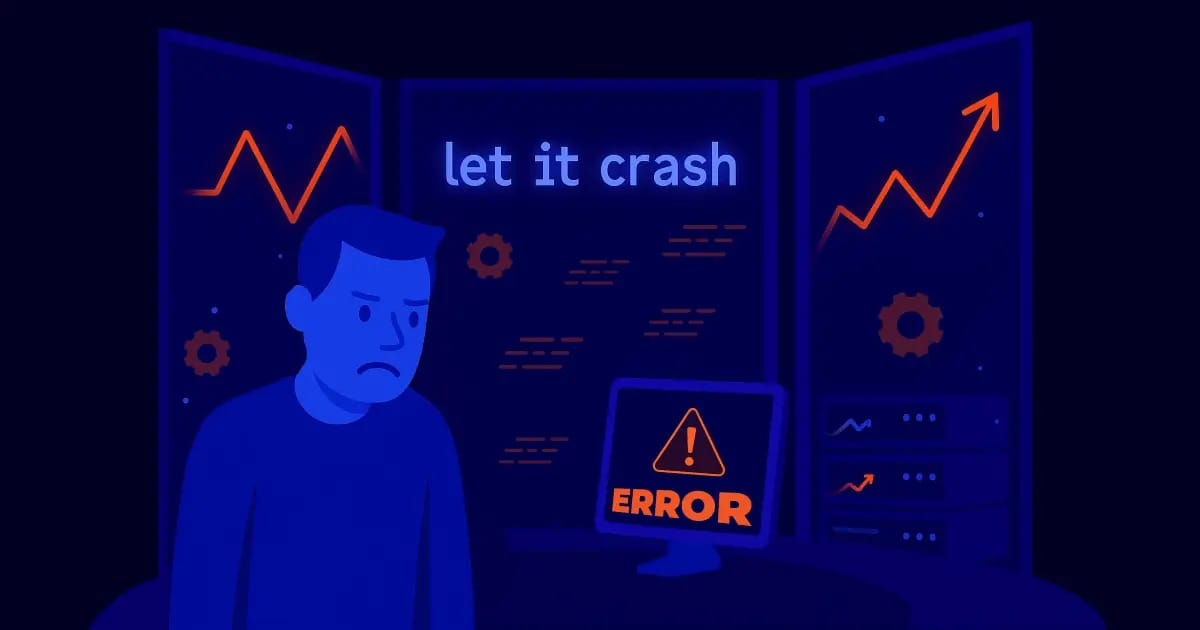- GigaElixir Gazette
- Posts
- The "Let it Crash" Lie
The "Let it Crash" Lie
Real error handling + file organization breakthrough
Welcome to GigaElixir Gazette, your 5-minute digest of Elixir ecosystem news that actually matters 👋.
. WEEKLY PICKS .
🤯 File Organization Debates Are Productivity Theater: Why do teams waste endless hours debating folder structures? Dogweather drops the truth bomb: you're solving the wrong problem entirely. The real issue isn't "how do we organize files better" but "why are we organizing files at all?" Every time you agonize over where that customer email notification worker goes, you're forcing multi-dimensional concepts into single hierarchical paths.
Most teams remain trapped in filesystem thinking. Smart developers focus on modules, functions, concepts, and relationships instead. The Smalltalk crowd solved this decades ago – they built tools around how developers actually think, not how Unix organizes directories.
🚀 Hologram Just Embarrassed Every JavaScript Framework: Full-stack Elixir isn't supposed to be this fast. Hologram v0.5.0 moves client-side execution from milliseconds to microseconds – that's 50x faster rendering performance that makes React look sluggish. With 950 commits of architectural rewrites, this proves you don't need JavaScript's performance tax for responsive real-time interactions.
Everyone else accepts that client-side frameworks cost performance. Hologram delivers mouse move events that feel native because functional programming actually wins when done right. The SVG Drawing Demo responds faster than most pure JS implementations.
🍞 Phoenix Flash Messages Look Like 2010 Garbage: Phoenix's flash messages are an embarrassment. Toast drops as the upgrade every Phoenix app desperately needs – stackable notifications with smooth animations that don't make your users cringe. The genius move: your existing put_flash() calls work unchanged, they just stop looking terrible.
Teams still tolerate ugly, single-message flash notifications because "they work fine." Professional applications install Toast and immediately provide better user feedback without touching existing code.
🎯 Watch a Go Developer's Mind Get Blown: Primagen's livestream captures the exact moment pattern matching converts another developer. His reaction to eliminating entire conditional blocks with declarative function clauses is pure gold – this is why functional programming evangelists exist. The with statement revelation comes next: clean error handling pipelines instead of nested try-catch hell.
Go developers think they've seen concurrency until they meet Elixir's actor model. Watching someone discover that error handling can be elegant instead of tedious never gets old.
⚡ Claude Code Was Broken Until Now: Managing Claude Code across multiple Elixir projects was pure nightmare fuel until Bradley Golden solved it. One mix claude.install command automatically configures project-specific hooks, eliminates manual setup, and integrates with your existing ecosystem. No more copying configurations or debugging broken setups.
The vision goes deeper – imagine libraries defining their own Claude rules, Phoenix LiveView providing specialized UI agents, or Usage Rules automatically teaching Claude your domain patterns. This is how AI tooling should work.
. PRO TIPS .

Stop Saying "Let it Crash" - Your Users Deserve Better Error Handling
Zach Daniel's latest post challenges Elixir's most sacred phrase, and he's absolutely right. The community's obsession with "let it crash" is destroying user experience because this phrase encourages lazy error handling that treats every failure the same way – by nuking the process and hoping for the best. Your LiveView crashes on invalid input? Congratulations, your user just lost their websocket connection, UI state, and patience.
Everyone parrots "let it crash" without understanding what crashes. The "it" refers to a process, not your application. Beginners crash on every validation error because it's "the Elixir way." Experienced teams distinguish between unrecoverable system failures and user-facing problems that need graceful handling.
Here's what crashes actually do to real users: websocket reconnection delays, lost form data, confused UI states, and generic error messages. A file import that crashes on malformed data destroys upload progress and provides zero actionable feedback. Handling the error preserves user context and shows specific validation failures.
The BEAM's superpower isn't that processes crash – it's that they heal. Every process knows how to initialize itself, so supervisors can always restart crashed processes in good states. But restarting is expensive, and user experience should drive error handling decisions, not philosophical purity about fault tolerance.
Remember, for bulletproof error handling:
Crash on impossible system states – malformed messages, corrupted data, unrecoverable failures
Handle user errors gracefully – validation failures, bad input, expected edge cases
Preserve user context – websocket connections, form state, UI interactions
Design for healing – processes that restart cleanly, not just processes that crash elegantly
. TIRED OF DEVOPS HEADACHES? .
Deploy your next Elixir app hassle-free with Gigalixir and focus more on coding, less on ops.
We're specifically designed to support all the features that make Elixir special, so you can keep building amazing things without becoming a DevOps expert.
See you next week,
Michael
P.S. Forward this to a friend who loves Elixir as much as you do 💜